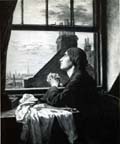Next to being a citizen of the world, it must be the best thing to be born a citizen of the world's greatest city. (Thomas Hood, Literary Reminiscences)
 ike his contemporary Leigh Hunt (1784-1859), who was a journalist, essayist, and co-founder of the radical weekly journal the Examiner (1808), Thomas Hood is not easily classified as either a Romantic or a Victorian writer. In fact his work spans both periods. Son of a London bookseller, Hood apprenticed as an engraver until ill health compelled him to turn to writing. From 1815 to 1821 he worked as a journalist in Dundee, Scotland. While working as the sub-editor of the London Magazine, he met notable writers of the Romantic epoch, among them the essayists Thomas de Quincey, Charles Lamb, and William Hazlitt, as well as the poets Samuel Taylor Coleridge and John Clare. With his brother-in-law, John Hamilton Reynolds, he collaborated on the popular Odes and Addresses to a Great People (1825), and subsequently published Whims and Oddities (1826-27), which contain his unique "picture-puns" and the proletarian comic poems "Faithless Nelly Gray" and "The Ballad of Sally Brown and Ben the Carpenter." From 1828 he was a regular contributor to the Athenaeum, edited by James Silk Buckingham. As editor of The Gem in 1829 he published some of Tennyson's early poems, and he founded The Comic Annual (1830-42). Financial reversal as a publisher compelled Hood to live in Koblenz and Ostend from 1835, but in 1840 he returned and began writing for The New Monthly Magazine, of which he became editor in 1841. In 1844, he founded Hood's Monthly Magazine, which his son continued publishing for three years after his death. His Whimsicalities (1844) was illustrated by well-known Punch artist John Leech.
ike his contemporary Leigh Hunt (1784-1859), who was a journalist, essayist, and co-founder of the radical weekly journal the Examiner (1808), Thomas Hood is not easily classified as either a Romantic or a Victorian writer. In fact his work spans both periods. Son of a London bookseller, Hood apprenticed as an engraver until ill health compelled him to turn to writing. From 1815 to 1821 he worked as a journalist in Dundee, Scotland. While working as the sub-editor of the London Magazine, he met notable writers of the Romantic epoch, among them the essayists Thomas de Quincey, Charles Lamb, and William Hazlitt, as well as the poets Samuel Taylor Coleridge and John Clare. With his brother-in-law, John Hamilton Reynolds, he collaborated on the popular Odes and Addresses to a Great People (1825), and subsequently published Whims and Oddities (1826-27), which contain his unique "picture-puns" and the proletarian comic poems "Faithless Nelly Gray" and "The Ballad of Sally Brown and Ben the Carpenter." From 1828 he was a regular contributor to the Athenaeum, edited by James Silk Buckingham. As editor of The Gem in 1829 he published some of Tennyson's early poems, and he founded The Comic Annual (1830-42). Financial reversal as a publisher compelled Hood to live in Koblenz and Ostend from 1835, but in 1840 he returned and began writing for The New Monthly Magazine, of which he became editor in 1841. In 1844, he founded Hood's Monthly Magazine, which his son continued publishing for three years after his death. His Whimsicalities (1844) was illustrated by well-known Punch artist John Leech.

Anna Elizabeth Blunden (Mrs. Martino), 1830-1915, The Seamstress (A Song of the Shirt), 1854.
Despite the contemporary popularity of his triple-decker novel Tylney Hall (1834) and his reputation as a humourist, Tom Hood is best known as the author of "The Song of the Shirt," which he published anonymously in the extra Christmas number of London's newest and most celebrated comic weekly magazine, Punch, in 1843. The poem is, however, grim social realism. Based on a previous account by Punch editor Douglas Jerrold of a woman accused of pawning articles belonging to her employer, the poem attacks the exploitation of the cheap labour of seamstresses, the poem was quickly reprinted in The Times, and translated into German, French, Italian, and Russian for newspaper publication abroad. It was even adapted for the stage by Punch staff writer Mark Lemon as The Seamstress. As a result of this and other works, such as "The Song of the Labourer," which stimulated the Victorian social conscience, a monument to his memory, raised by a subscription inaugurated by Richard Monckton Milnes, was installed at Hood's grave in London's Kensal Green Cemetery.
Related Material
References
"Hood, Thomas." The Cambridge Guide to Literature in English, ed. Ian Ousby. Cambridge: Cambridge UP, 2003. Pp. 448-49.
"Hood, Thomas." Chambers Biographical Dictionary, ed. Una McGovern. Edinburgh: Chambers, 2003. P. 746.
Last modified 9 May 2025